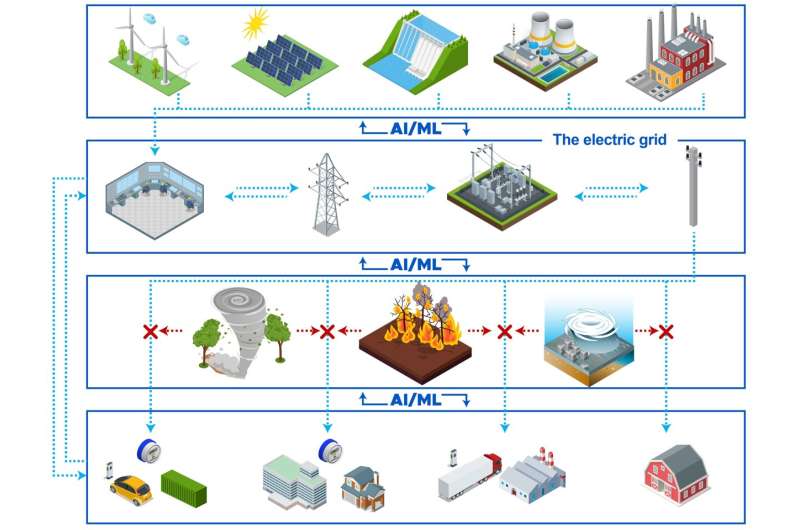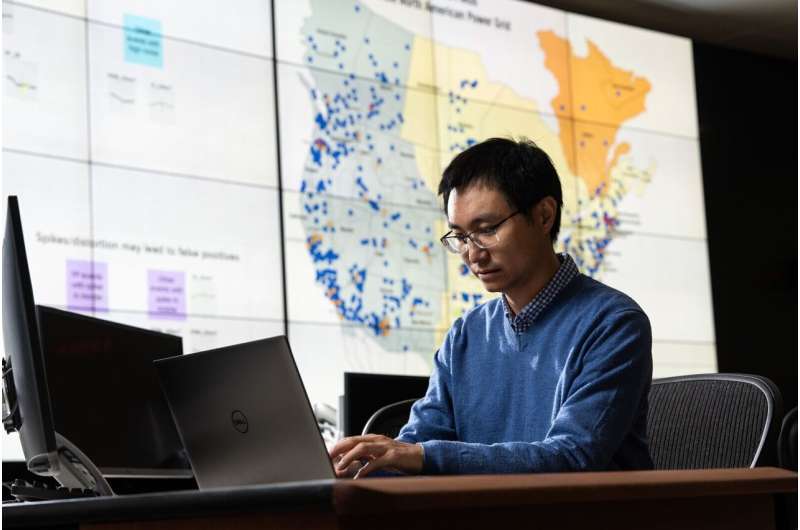This article has been reviewed according to Science X's editorial process and policies. Editors have highlighted the following attributes while ensuring the content's credibility:
fact-checked
trusted source
proofread
Report points the way toward an electric grid that thinks ahead

When we flip the light switch in our homes, we have come to expect instant access to electricity. Behind the scenes, that reliability depends on utility operators who have developed control systems and fail-safes to keep the power flowing.
But times are changing rapidly, and utility operators face an evolving electrical grid that has become a complex network of diverse energy sources, emerging grid energy storage options, and accelerating demand for electricity in transportation, computing, and industrial uses.
Faced with the challenge of electric grid modernization, many have called for supporting utility managers and operators with artificial intelligence (AI) and machine learning (ML) tools that can remove some of their decision-making burden.
Understandably, utilities are cautious about adopting new technologies when the consequences of failure are costly and could affect customers. Additionally, the benefits and business cases for these technologies are not yet clear.
Now, a research team led by Pacific Northwest National Laboratory has demystified their emerging role in the electric grid with practical advice. In a comprehensive report, the team points toward a time when ML can become a trusted partner for the nation's utility operators. As a branch of AI, ML uses mathematical models and real-world data to make decisions based on logic and prior knowledge.
"Electric utility operators are looking for tools that help them understand current system status, to predict what will happen in the future, and then present a recommendation to what kind of actions they need to take to prepare for that future," said Yousu Chen, a PNNL power-system modeling and simulation expert. Currently, he leads the Department of Energy's Office of Electricity Advanced Grid Modeling program at PNNL.
Chen and his team provide expert guidance that outlines the challenges and opportunities provided by ML to help manage an increasingly complex electric grid and describe some of the tools that have been developed.
Complexity rules the electric grid; machine learning can help us cope
For more than a century, the nation's electric grid operated with centralized energy production from coal, gas, hydro, and nuclear power stations. Today, that infrastructure is rapidly evolving to include a much wider variety of energy sources with different attributes, alongside much greater demand for electricity to power advanced manufacturing, transportation, and computing infrastructure.
Modern data management and computing strategies that include ML have shown promise to help manage our power grid, according to Chen and his colleagues. The biggest challenge to adoption in 2024 is confidence in the technology, Chen says.
As outlined in the full report, there are several challenges that must be thoughtfully addressed. They include:
Trustworthy answers: PNNL researchers took a close look at an ML algorithm applied to power systems. After training it on real data from the grid's Eastern Interconnection, they found the algorithm was 85% reliable in its decisions.
This is called a "confidence score," a value that reflects how confident the system is in its decisions. When the researchers put human experts in the loop, they saw a marked improvement over the system's assessment of its own decisions. PNNL researchers call the human-in-the-loop score an "expert-derived confidence," or EDC score.
They found that, on average, when humans weighed in on the data, their EDC scores predicted model behavior that the algorithm's confidence scores couldn't predict alone.
Cyber threats: Safeguarding information from cyber threats is an ever-present necessity for power systems, and the use of machine learning could compound that vulnerability by creating more potential points of entry for attackers, unless thoughtfully addressed.
However, anomaly detection algorithms now in development at PNNL flag unusual activity, such as abnormal data traffic or irregular data access patterns, ultimately enabling quicker responses to potential breaches. The PowerDrone project developed AI methods to defend cyber-physical systems, such as the power grid, from cyberattacks.
Model accuracy and adaptability: Computing models and digital twin technology must adapt to changing conditions. Continuous learning and model refinement are necessary to maintain effectiveness over time. Chen and his colleagues are creating adaptable models that help predict power-system vulnerability levels in response to weather and human threats and hazards, while also proposing potential remediation and restoration strategies.
Infrastructure investment and grid modernization: Most power systems are currently not prepared to incorporate intelligent systems. Cost and long-term sustainability must be considered carefully in making an investment. But once an investment has been made, smart grids can rapidly respond to system changes and improve overall efficiency, helping to recoup an initial investment.
For example, PNNL's Dynamic Contingency Analysis Tool uses cascading failure analyses to screen for weak spots on the grid, suggesting corrective actions that would be implemented during the response to the event. With DCAT, electrical utility companies can identify power instability during extreme events and have a greater chance of stopping a domino effect of power loss that can lead to a blackout.

"We are talking about a fundamental shift in how we operate the grid, moving from one centralized brain, so to speak, to a sponge, adsorbing data from lots of decentralized data sources and providing recommendations based on that data analysis," said Chen. "By moving machine learning to local control, instant local decision-making becomes feasible."
What does that local control look like?
Demand prediction: By analyzing real-time data, ML can help predict demand to forecast energy needs more accurately, helping balance the grid and reduce waste. Over time, AI can also identify trends in energy use, enabling better planning and investment in infrastructure, making our energy systems more efficient and reliable.
Fault detection and prevention: Sensors installed on equipment such as transformers, circuit breakers and generators can continuously monitor operating conditions and feed data to algorithms that predict potential issues before they lead to system failures.
For example, PNNL's Shaobu Wang leads a team exploring how to make the grid more resilient amid uncertain weather conditions. The team is exploring how to use adaptively changing control of wind turbines based on real-time operation conditions using AI approaches to increase reliability and extend equipment lifespan.
Human–machine interaction: Confidence in human–machine interactions is critical for the adoption and acceptance of AI/ML techniques in the power industry. Further research will need to focus on defining clear roles for humans within the systems, interfaces, and workflows so that operators have confidence in the recommendations made by algorithms.
System reliability: The complexity brought by renewable integration has led to new grid behaviors and posed challenges to existing protection relay settings, which, if not properly addressed, can potentially cause cascading failures.
PNNL's Xiaoyuan Fan and a team of computational scientists worked closely with the power industry to model preventive controls that stop cascading power failure triggered by intermittent energy inputs.
With modern ML and humans in the decision-making loop, it will be possible to intelligently grow the grid, efficiently integrate renewable energy, and substantially harden our infrastructure for a more robust and reliable nationwide power system for future generations.
More information: Report: Artificial Intelligence/Machine Learning Technology in Power System Applications















